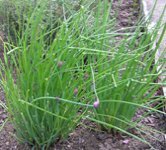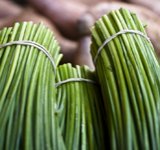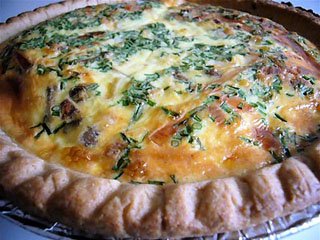Chives Nutrition facts
Sweet, mild-onion flavored chives are fresh, top greens of chive plant in the onion family of bulb vegetables. Its stiff, hollow, tubular leaves appear similar to that of onions, but smaller in diameter, and look somewhat like "grass-blades" from a distance.
Botanically, their bright green leaf tubules belong to the family of Alliaceae, of the genus: Allium.
Scientific name: Allium schoenoprasum (common or onion chives).

|

|
| Chives-Allium schoenoprasum. Photo courtesy: ryansnyder |
Fresh farm produce! Photo courtesy: a.pitch |
Chives should not be confused with green-onions, which are top greens of young, immature onion plants AND to scallions, which are top greens of Allium fistulosum (Welsh onion). Along with chervil, parsley, and tarragon, chive makes the perfectly "balanced quartet" of classic French fines herbes (fine herbs).
Chives are small perennial herbs growing in clumps, probably originated in Siberian highlands. The herb grows best in full sun and well-drained soil. Its saplings can be grown from seeds or divisions of 2 to 3 bulbs. The completely grown plant reaches about 8-12 inches in height.
In the fields, farmers prune their leaves periodically to check the vigorous growth of the crop. In fact, all plantings should be divided every two to three years to prevent overcrowding and root diseases. Unlike onions and garlic, chive’s tiny underground bulbs have an unpleasant taste and, therefore, are not sought after in cooking.
The flower stems, which rise directly from the base, grow slightly taller than leaves and bear small clusters of mauve or purple flower heads.
Some of the different cultivars of chives include:
1. Giant Siberian (Allium ledebourianum),
2. Chinese or garlic chives (Allium tuberosum),
3. Siberian garlic types (Allium nutans).
Health benefits of Chives
Chives are very low in calories; 100 g of fresh leaves provide just 30 calories. Nonetheless, they contain many unique flavonoid anti-oxidants, plant fiber, minerals, and vitamins that have proven health benefits.
As in scallions, they too contain more plant-derived dietary fiber than fellow allium members such as onions, shallots, leeks, etc. 100 g fresh leaves provide 2.5 g or 7% of the daily recommended levels of fiber.
Just like in other allium members, chives too possess thiosulfonates antioxidants. Thiosufonates such as diallyl disulfide, diallyl trisulfide, and allyl propyl disulfide convert to allicin by the enzymatic reaction when its leaves disrupted (crushing, cutting, etc.). Laboratory studies show that allicin reduces cholesterol production by inhibiting the HMG-CoA reductase enzyme in the liver cells. Further, it was also found to have antibacterial, antiviral, and anti-fungal activities.
Additionally, allicin also decreases blood vessel stiffness by releasing vasodilator compound, nitric oxide (NO); and, thereby, help reduce total blood pressure. Also, it blocks platelet clot formation, besides having fibrinolytic (breaking a clot) action in the blood vessels. All in all, allicin helps decrease the overall risk of coronary artery disease (CAD), peripheral vascular diseases (PVD), and stroke.
Chives surprisingly comprise more vitamin-A than any other allium family member vegetables. 100 g of fresh leaves contain 4,353 IU of vitamin-A or 145% of daily recommended levels. Besides, oxidants such as carotenes, zeaxanthin, and lutein. Together, these compounds offer human protection from lung and oral cavity cancers.
They also have some other essential vitamins such as vitamin-C, and K, in fact; chives are one of the richest sources of vitamin-K, comparatively more than that of in scallions. 100 g of fresh greens provide 212.7 µg or about 177% of daily recommended intake of this vitamin. Scientific studies suggest that vitamin K has a potential role in bone health by promoting osteoblastic (bone formation and strengthening) activity. Adequate vitamin-K levels in the diet help limit neuronal damage in the brain; thus, has an established role in the treatment of Alzheimer's disease.
Fresh chives are rich sources of folates. 100 g leaves provide 105 µg or 26% of DRI of folates. Folic acid is essential for DNA synthesis and cell division. Adequate folate levels in the diet during pregnancy may help prevent neural tube defects in newborn babies.
Furthermore, the leaves are packed with other B-complex vitamins as well as some essential minerals such as copper, iron, manganese, zinc, and calcium. The leafy greens contain several vital vitamins such as pyridoxine, pantothenic acid, niacin, riboflavin, and thiamin in good proportions.
| Principle | Nutrient Value | Percent of RDA |
|---|---|---|
| Energy | 30 Kcal | 1% |
| Carbohydrates | 4.35 g | 3% |
| Protein | 3.27 g | 6% |
| Total Fat | 0.73 g | 3% |
| Cholesterol | 0 mg | 0% |
| Dietary Fiber | 2.5 g | 7% |
| Vitamins | ||
| Folates | 105 µg | 26% |
| Niacin | 0.647 mg | 4% |
| Pantothenic acid | 0.324 mg | 6.5% |
| Pyridoxine | 0.138 mg | 11% |
| Riboflavin | 0.115 mg | 9% |
| Thiamin | 0.078 mg | 6.5% |
| Vitamin A | 4353 IU | 145% |
| Vitamin C | 58.1 mg | 98% |
| Vitamin E | 0.21 mg | 1.5% |
| Vitamin K | 212.7 µg | 177% |
| Electrolytes | ||
| Sodium | 3 mg | <0.5% |
| Potassium | 296 mg | 6% |
| Minerals | ||
| Calcium | 92 mg | 9% |
| Copper | 0.157 mg | 17% |
| Iron | 1.60 mg | 20% |
| Magnesium | 42 mg | 10.5% |
| Manganese | 0.373 mg | 16% |
| Phosphorus | 58 mg | 8% |
| Selenium | 0.9 µg | 2% |
| Zinc | 0.56 mg | 5% |
| Phyto-nutrients | ||
| Carotene-ß | 2612 µg | -- |
| Crypto-xanthin-ß | 0 µg | -- |
| Lutein-zeaxanthin | 323 µg | -- |
Selection and storage
Chives can be available year-round. If you grow them as a potherb, the leaves can be harvested after plants are 6 inches tall. To harvest, just cut the leaves 2 inches above the ground.
In the markets, you may choose fresh as well as dried (dehydrated) leaves. Generally, fresh leaves are tied in bunches (bundles) and displayed for sale along with other leafy greens.
Buy uniform, firm, deep green fresh leaf-bunch (bushel). Choose young leaves for a mild flavor. Larger leaves tend to have a sharp, strong onion-like pungent flavor.
You may store fresh leaves in a plastic bag and keep them in the refrigerator. Dry greens may be placed in an air-seal container and stored in a cool, dark place.
Preparation and serving methods
 |
| Quiche- caramelized onions, shallots, porcini, emmental cheese, and chives. Photo:dizznbonn |
Chives are one of the most sought-after ingredients used for flavoring and garnishing recipes in many parts of the world, especially in the French and Mediterranean cuisines. They impart subtle onion flavor, besides giving a bright green color to the recipes.
To prepare, wash chives in a bowl of cold water. Get them dry by gently mopping them with a paper towel. Chop the leaves closely using a paring knife in a way you desire. Add in the final moments to prevent loss of flavor (essential oils).
Here are some serving tips:
Fresh chopped leaves add great taste to mint, cucumber, shallot, parsley, tomato salad.
Closely chopped fresh leaves are added to sandwiches, soups, and cold sauces.
Garlic chives are popular in China, Taiwan, and Japan, where the fresh leaves are used as flavorings in dumplings, soups, stews, and stir-fries.
In Europe, chives are mainly used as garnishing, especially in baked, or mashed and cream cheese mixed potatoes. Vichyssoise, a classic cold soup, is served with freshly chopped chives.
The herb is also employed in muffins, scones, quiche, pizza, omelets, biscuits, etc.
≻≻-Back to Herbs from Chives. Visit here for an impressive list of all variety of herbs with complete illustrations of their nutrition facts and health benefits.
≻≻-Back to Home page.
Further Resources:
Stanford School of Medicine Cancer information Page- Nutrition to Reduce Cancer Risk (Link opens in new window).